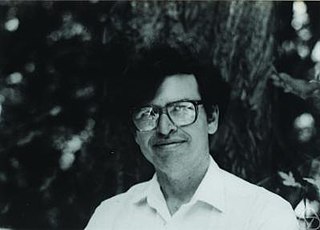Related Research Articles

William Paul Thurston was an American mathematician. He was a pioneer in the field of low-dimensional topology and was awarded the Fields Medal in 1982 for his contributions to the study of 3-manifolds.

In mathematics, Thurston's geometrization conjecture states that each of certain three-dimensional topological spaces has a unique geometric structure that can be associated with it. It is an analogue of the uniformization theorem for two-dimensional surfaces, which states that every simply connected Riemann surface can be given one of three geometries.
In mathematics, a Haken manifold is a compact, P²-irreducible 3-manifold that is sufficiently large, meaning that it contains a properly embedded two-sided incompressible surface. Sometimes one considers only orientable Haken manifolds, in which case a Haken manifold is a compact, orientable, irreducible 3-manifold that contains an orientable, incompressible surface.

In mathematics, a 3-manifold is a topological space that locally looks like a three-dimensional Euclidean space. A 3-manifold can be thought of as a possible shape of the universe. Just as a sphere looks like a plane to a small and close enough observer, all 3-manifolds look like our universe does to a small enough observer. This is made more precise in the definition below.
In mathematics, more precisely in topology and differential geometry, a hyperbolic 3-manifold is a manifold of dimension 3 equipped with a hyperbolic metric, that is a Riemannian metric which has all its sectional curvatures equal to −1. It is generally required that this metric be also complete: in this case the manifold can be realised as a quotient of the 3-dimensional hyperbolic space by a discrete group of isometries.
In mathematics, hyperbolic Dehn surgery is an operation by which one can obtain further hyperbolic 3-manifolds from a given cusped hyperbolic 3-manifold. Hyperbolic Dehn surgery exists only in dimension three and is one which distinguishes hyperbolic geometry in three dimensions from other dimensions.
In mathematics, the tameness theorem states that every complete hyperbolic 3-manifold with finitely generated fundamental group is topologically tame, in other words homeomorphic to the interior of a compact 3-manifold.
In topology, an area of mathematics, the virtually Haken conjecture states that every compact, orientable, irreducible three-dimensional manifold with infinite fundamental group is virtually Haken. That is, it has a finite cover that is a Haken manifold.

In the mathematical field of knot theory, the hyperbolic volume of a hyperbolic link is the volume of the link's complement with respect to its complete hyperbolic metric. The volume is necessarily a finite real number, and is a topological invariant of the link. As a link invariant, it was first studied by William Thurston in connection with his geometrization conjecture.
In geometry, Thurston's geometrization theorem or hyperbolization theorem implies that closed atoroidal Haken manifolds are hyperbolic, and in particular satisfy the Thurston conjecture.
In mathematics, the 2π theorem of Gromov and Thurston states a sufficient condition for Dehn filling on a cusped hyperbolic 3-manifold to result in a negatively curved 3-manifold.
In mathematics, more precisely in group theory and hyperbolic geometry, Arithmetic Kleinian groups are a special class of Kleinian groups constructed using orders in quaternion algebras. They are particular instances of arithmetic groups. An arithmetic hyperbolic three-manifold is the quotient of hyperbolic space by an arithmetic Kleinian group.
James W. Cannon is an American mathematician working in the areas of low-dimensional topology and geometric group theory. He was an Orson Pratt Professor of Mathematics at Brigham Young University.
In mathematics, the Ahlfors conjecture, now a theorem, states that the limit set of a finitely-generated Kleinian group is either the whole Riemann sphere, or has measure 0.
In the mathematical theory of Kleinian groups, the density conjecture of Lipman Bers, Dennis Sullivan, and William Thurston, later proved independently by Namazi & Souto (2012) and Ohshika (2011), states that every finitely generated Kleinian group is an algebraic limit of geometrically finite Kleinian groups.

Ian Agol is an American mathematician who deals primarily with the topology of three-dimensional manifolds.

Daniel T. Wise is an American mathematician who specializes in geometric group theory and 3-manifolds. He is a professor of mathematics at McGill University. Wise's conjecture is named after him.

In mathematics, a cubical complex is a set composed of points, line segments, squares, cubes, and their n-dimensional counterparts. They are used analogously to simplicial complexes and CW complexes in the computation of the homology of topological spaces. Non-positively curved and CAT(0) cube complexes appear with increasing significance in geometric group theory.
Albert Marden is an American mathematician, specializing in complex analysis and hyperbolic geometry.
Pekka Pertti Tukia is a Finnish mathematician who does research on Kleinian groups and their geometric properties.
References
- Thurston, William P. (1982). "Three dimensional manifolds, Kleinian groups and hyperbolic geometry". Bulletin of the American Mathematical Society. 6 (3): 357–382. CiteSeerX 10.1.1.535.7618 . doi: 10.1090/S0273-0979-1982-15003-0 .
- D. Gabai, On 3-manifold finitely covered by surface bundles, Low Dimensional Topology and Kleinian Groups (ed: D.B.A. Epstein), London Mathematical Society Lecture Note Series vol 112 (1986), p. 145-155.
- Agol, Ian (2008). "Criteria for virtual fibering". Journal of Topology. 1 (2): 269–284. arXiv: 0707.4522 . doi:10.1112/jtopol/jtn003. S2CID 3028314.